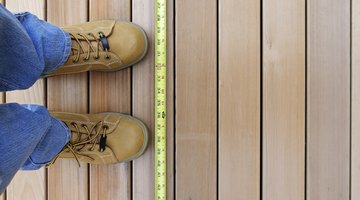How to Build a Wood Deck Over a Concrete Patio
An old, cracked, partially sunken concrete patio can be an eyesore if not a safety hazard. Demolishing it and replacing it with new poured concrete is an economical but extremely labor-intensive process. Instead, consider covering your aging concrete patio with decking.

Select from a variety of materials including treated lumber such as pine or cedar or lower-maintenance products like composite decking or PVC. Start by securing two-by-four runners, or sleepers, to the concrete, then attach decking to the runners. Keep drainage in mind, and the end result is an attractive, durable surface.
Things You Will Need
- Concrete topping mix
- Chalk line
- Treated two-by-fours
- 4-foot level
- Hammer drill
- Impact driver
- Decking material
- Shims
- 3 ¼-inch concrete screws
- Flashing tape
- Silicone
- Circular saw
-
Check the drainage of the concrete patio. Fill in any spots where rainwater pools with either self-leveling compound or a concrete topping mix. Clean the area thoroughly, mix and pour your chosen material into the sunken area and run a straightedge over the newly poured mix until it is level with the surrounding concrete. Allow the repaired concrete to cure completely.
-
Plan the layout of your sleepers. They will run perpendicular to the decking material. Consider drainage again in the layout. Patios typically drain away from the house. In that instance, if your sleepers are perpendicular to the house, they will not impede drainage, but if they are parallel to the house, they may. Refer to your chosen decking material’s specifications for the maximum allowable distance between supports. Snap chalk lines where each sleeper will be placed. Make special compensations for any decking material that you plan to lay in a different direction such, as parallel to the sleepers or diagonally. Runners should overhang the patio when first installed.
-
Find the high point of your patio by a laying a flat board across the patio where you plan to install your sleepers. The sleepers can follow the slope of the patio rather than being perfectly level, but they do need to create a flat plane to properly support the decking.
-
Secure the first sleeper at the high point. Working your way out from there, use shims to create a flat plane. Drill pilot holes a maximum of 24 inches apart along the sleeper, using a hammer drill to drill through the wood and into the concrete ¼ inch to ½ inch deeper than the length of your screws. Drive concrete screws into each hole with an impact driver. Similarly install additional sleepers, moving out from the high point, using a 4-foot level and shims to maintain a flat plane.
-
Fill screw holes and any knots in the wood with silicone. Run flashing tape along the top of the runners.
-
Install the first deck board. If a single board will not span the width of the patio, cut it with a circular saw so that its end lands on the middle of a sleeper. Take extra caution to ensure that the first course is aligned correctly because successive courses will run parallel to it. Secure it to the sleepers as per the manufacturer’s instructions.
-
Place the second course of deck boards. Leave the amount of space recommended by the manufacturer between courses to allow for expansion and drainage. If necessary, use spacers cut from scrap wood to maintain even spacing. Secure the second course to the sleepers and continue installing successive courses. Stagger joints in a random pattern to minimize their appearance.
-
Cut the sleepers and any overhanging deck boards to length with a circular saw. Attach skirt boards or trim around the outside of the deck and to any other vertical surfaces.
Tip
When filling in depressed areas of the existing patio to create drainage, choose self-leveling compound if time is of the essence as it cures faster. If cost is a bigger factor, choose a concrete topping mix. To ensure proper drainage, particularly when sleepers run parallel to the house, consider placing the ½-inch spacers beneath the runners to allow water to run freely underneath.
Warning
Installing decking over a concrete patio raises the level of the patio. Doors that open onto the patio may need to be raised.
Follow proper safety precautions, including wearing eye protection when using power tools.
The Drip Cap
- An old, cracked, partially sunken concrete patio can be an eyesore if not a safety hazard.
- The sleepers can follow the slope of the patio rather than being perfectly level, but they do need to create a flat plane to properly support the decking.
- Working your way out from there, use shims to create a flat plane.
- Fill screw holes and any knots in the wood with silicone.
- Run flashing tape along the top of the runners.
- Leave the amount of space recommended by the manufacturer between courses to allow for expansion and drainage.
- If necessary, use spacers cut from scrap wood to maintain even spacing.
- Secure the second course to the sleepers and continue installing successive courses.
References
Writer Bio
Matt Brown has been writing professionally for more than 15 years. He shares his experience in home remodeling and do-it-yourself projects with his readers. Brown earned his bachelor of arts in communications from Marist College in Poughkeepsie, N.Y.
Photo Credits
- EJ-J/iStock/Getty Images
- EJ-J/iStock/Getty Images
More Articles



